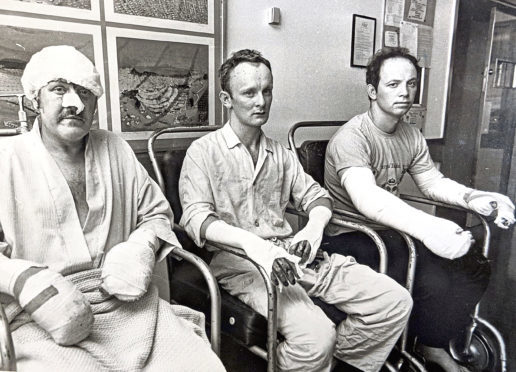The physical injuries of those who escaped were more easily mended than the psychological. Both left scars. The son of one survivor knows from painful experience just how deep they can run.

The earliest memory Marc Reid has of his father was that his hands looked different to other people’s – badly scarred during his escape from the blazing Piper Alpha platform.
This haunting photograph from the time shows Mark Archibald Reid sat between other survivors in hospital, where the brand new burns unit had been opened ahead of schedule.
But while medical staff were able to treat his physical wounds, it was the psychological damage that was never repaired.
When he hurled himself down into the sea, he had no idea that from that moment his life would forever be in free-fall – blighted by post-traumatic stress disorder (PTSD) and drinking.
An alcohol-related illness ended his life at 48, and so it is left to Marc, who was just three months old at the time of the disaster, to tell his story.
“The first thing that I noticed about my dad was that his hands looked different from other men – they looked older than other people’s hands,” he said.
“There were burn scars from what he’d experienced.
“Growing up, my dad was quite forthcoming about a lot of it. It was never described as anything more than an accident when I was really young. But as I grew up I could understand more and that’s when the real details emerged.”
As Marc Reid grew, so too did his father’s need to tell his son what happened that night when an oil rig exploded and a fire engulfed it, killing 167 of his workmates.
170ft plunge
“He essentially had to worm his way up through doors and ladders in what seemed like a labyrinth to eventually get up to the highest part of the platform, which was the helipad. From there he had to run and jump off into the sea as that was the only way off at that point.”
Even after the 170ft plunge, there was the bitter North Sea temperature to contend with and a horrific scene waiting for him on the surface of the water.
“The fact that he actually survived when he hit the water was the first real shock. These details emerged over time. Though he struggled with it his entire life, he was sensitive enough not to let me hear anything too horrific at too young an age.
“The final thing I remember him talking about was when he eventually got himself to the surface of the water. He and a few scattered survivors had little to grab on to. The only things were bodies. Friends, colleagues, people he might not have known, but were all immediately thrust into this situation that they had to do things to survive that they never thought would ever occur in their lives.
“It’s instinct or remembering whatever training they had. Then wait for their eventual rescue.
“It was so many dominoes that had to fall, from whatever their decision was, in order for the last one to mean they survived, rather than be one of the 167 who didn’t.”
Support for those who lived often falls far down the list of priorities when there is so much heartache and devastation present.
Mr Reid said his father almost certainly felt some kind of “why me?” guilt – though that was one area he talked little about.
Lifelong struggle
“I think that’s ultimately part of the broader issue for survivors, which would’ve been post-traumatic stress. And that comes in many shapes and forms.
“Sadly, in my father’s case he did really struggle for the remainder of his life with that. His struggles were manifest in his intermittent alcoholism. That was his crutch. I saw a lot of that growing up.
“You understand fatalities in these events are one major horror to avoid but then of course for the people who survive, it’s the process of living with it.”
Mr Reid, a chemistry academic at Strathclyde University where he researches safety and training, had never seen the picture of his father until he spoke to the P&J for this anniversary.
“Wow. Seeing that picture was like pulling my father’s stories out of my head and holding them in my hands,” he said.
“I looked into the young, beaten eyes of my dad and knew I was working on safety training for all the right reasons.
“I’d love to hear from other people connected to the accident, and from safety professionals who have shared interests and challenges.”










